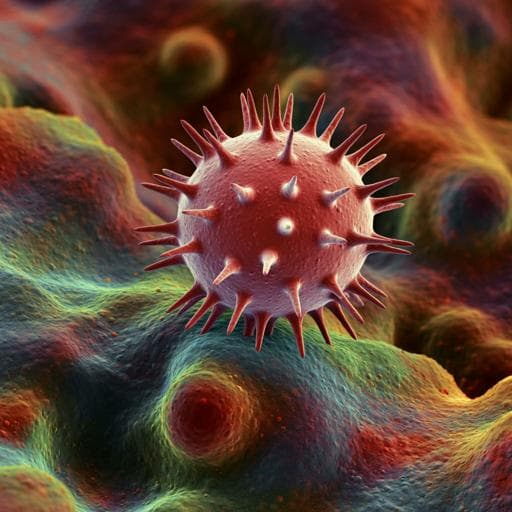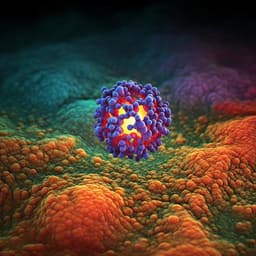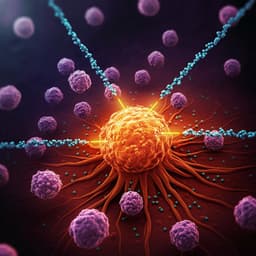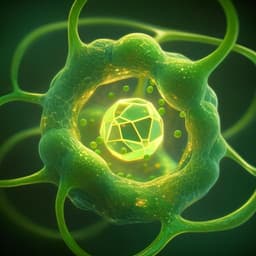
Medicine and Health
Nanoparticles exhibiting virus-mimic surface topology for enhanced oral delivery
Z. Sang, L. Xu, et al.
Discover the groundbreaking research conducted by Zhentao Sang and colleagues on oral delivery of nano-drug delivery systems! Their innovative core-shell mesoporous silica nanoparticles with virus-like nanospikes demonstrate remarkable improvements in drug delivery, stability, and absorption compared to traditional methods. This study paves the way for enhanced oral therapeutic applications.
~3 min • Beginner • English
Introduction
Oral nano-drug delivery systems commonly suffer from poor adhesion to intestinal mucosa, limited penetration through mucus, and insufficient epithelial uptake, leading to low bioavailability. Conventional spherical nanoparticles have small surface area-to-volume ratios and limited contact sites, which contribute to rapid clearance and weak bio-interactions. Viruses, by contrast, display nanoscale spikes, heterogeneous rough surfaces, and intrinsic chirality that collectively enable strong interface interactions and efficient penetration into tissues and cells. This study asks whether mimicking viral morphology and chirality in synthetic nanoparticles can enhance oral delivery. The objective is to construct virus-like mesoporous silica nanoparticles with spiky surfaces and L-alanine surface chirality (CVSN) to improve mucus penetration, mucosal adhesion, epithelial uptake, and systemic absorption, and to evaluate their performance and mechanisms versus smooth solid (SSN), mesoporous spherical (MSN), and non-chiral spiky (VSN) controls.
Literature Review
Prior work has shown that nanoparticle size, morphology, and surface chemistry critically affect oral delivery performance, and that stimuli-responsive and targeted systems can improve efficacy but still face mucus and epithelial barriers. Virus-inspired strategies have been explored, including direct use of viral vectors (adenovirus, adeno-associated virus) for gene delivery and virus-like particles for cargo stabilization and intracellular delivery. Surface topology and roughness in viruses provide abundant binding sites and increased friction, enhancing membrane interactions and endocytosis. Chirality is a defining feature of biological assemblies and can modulate recognition with biomolecules and membranes. Silica-based virus-like mesoporous particles have demonstrated enhanced cellular internalization, and chiral silica nanostructures have shown stereoselective interactions with intestinal mucosa. These insights motivate engineering nanoparticles that combine virus-like spiky topology with molecular chirality to overcome sequential gastrointestinal barriers.
Methodology
Nanoparticle synthesis: Four silica nanoparticle types were prepared. SSN (smooth, solid spheres) via Stöber method; MSN (spherical mesoporous) via CTAB-templated sol–gel and calcination; VSN (virus-like spiky mesoporous) via single-micelle epitaxial growth at an oil–water interface with CTAB, followed by calcination; CVSN obtained by grafting APTES onto VSN (AVSN) and coupling Boc-L-alanine via EDCI/HOBT, then Boc deprotection with TFA to yield L-Ala-functionalized spiky particles. DVSN (D-Ala) was also synthesized for chiral controls.
Characterization: FTIR, XPS, TGA, SAXS, N2 adsorption/desorption (BET/BJH), TEM/SEM/AFM imaging, DLS, and CD spectroscopy assessed structure, composition, mesoporosity, surface groups, and chirality. Surface/interface properties included surface hydroxyl density (from TGA and BET), oil–water partition (shaking method), wettability (contact angles), chiral amino acid adsorption (CD shifts and adsorption amounts), and stability/degradation in SGF (pH 1.2), SIF (pH 6.8), and SBF (pH 7.4). RITC labeling enabled fluorescence tracking.
Mucus permeation: 3D CLSM on rat intestinal segments stained with FITC assessed penetration. Human and rat mucus syringe model quantified 24 h permeation (bottom-layer fraction) at 37 °C.
Bio-adhesion and GI retention: An ex vivo elution device quantified nanoparticle adhesion on rat and human intestinal mucosa by weight loss and fluorescence imaging. In vivo GI retention in mice was visualized by IVIS after oral dosing with fluorescent NPs.
Intestinal villi absorption: In vivo (mouse) and ex vivo (rat and human intestinal segments) CLSM and bio-TEM assessed adsorption and translocation through villi. P-gp involvement was probed by preincubation with verapamil. Tight junction integrity was evaluated by ZO-1 and occludin immunofluorescence.
Oral bioavailability and biodistribution: Mice received oral NPs; plasma and organs were collected at defined times. Silicon levels (from silica NPs) were quantified by ICP-MS to determine plasma profiles (AUC, t1/2) and organ distribution. IVIS imaging provided qualitative organ signals.
Cellular uptake and mechanisms: Caco-2 cells incubated with RITC-labeled NPs were analyzed by CLSM, FCM, and bio-TEM. Endocytosis pathways were probed using chlorpromazine (clathrin-mediated), cytochalasin D (macropinocytosis), and methyl-β-cyclodextrin (caveolae-mediated), quantifying inhibition of uptake.
Biocompatibility: In vitro cytotoxicity (CCK-8), hemolysis and BSA protein adsorption assessed hemocompatibility. In vivo, mice received oral NPs; clinical observations, organ/body ratios, hematology/biochemistry, and H&E histology (major organs and GI tissues) were evaluated.
Drug loading and release: Indomethacin (IMC) was loaded into MSN, VSN, and CVSN via solvent evaporation (drug/carrier 1:3 w/w). FTIR, N2 sorption, XRD, and DSC confirmed loading and amorphization. Wettability (contact angle) and in vitro release in SGF and SIF (USP II, 37 °C) were measured.
Pharmacokinetics and pharmacodynamics: Rats received oral IMC, IMC@MSN, IMC@VSN, or IMC@CVSN (equivalent IMC 35 mg/kg); plasma IMC quantified by HPLC to compute PK parameters. Anti-inflammatory efficacy assessed by mouse ankle swelling test (MAST), mouse ear swelling test (MEST), and mouse writhing test (MWT); histopathology scored (0–4). GI irritation was assessed histologically.
Versatility: Additional NSAIDs (nimesulide, acetaminophen, aspirin, celecoxib, flurbiprofen, ibuprofen) were loaded into CVSN (1:3 w/w). FTIR/XRD characterized loading; ex vivo everted rat intestinal sacs measured 4 h transport; MEST assessed in vivo efficacy. Statistics: n=3 unless noted; mean ± SD; two-tailed Student’s t-test with significance at P<0.05.
Key Findings
Structure and surface properties:
- VSN and CVSN exhibit virus-like spiky rough surfaces; average particle size ~80 nm (hydrated ~130 nm). Mesopores confirmed by SAXS and N2 sorption (pore sizes: MSN 3.2 nm, VSN 2.9 nm, CVSN 2.5 nm). CVSN showed strongest wettability (fast contact angle drop to 0°) and hydrophilicity (negative oil–water partition), with highest interfacial reactivity.
- Surface hydroxyl density (Si–OH/nm²): SSN 1.60, MSN 4.65, VSN 5.57. TGA weight loss indicated successful L-Ala grafting on CVSN (~14.75% organic content).
- Chirality: CD confirmed L/D-configuration on CVSN/DVSN with opposite Cotton effects. Chiral adsorption favored homochiral interactions: CVSN adsorbed L-Ala 17.58 µg/mg vs D-Ala 7.72 µg/mg; DVSN adsorbed D-Ala 22.47 µg/mg vs L-Ala 8.22 µg/mg.
Mucus penetration:
- Human mucus 24 h permeation: SSN 11.58%, MSN 15.88%, VSN 23.80%, CVSN 23.19%. Rat mucus: SSN 10.47%, MSN 17.25%, VSN 23.68%, CVSN 27.01%. VSN/CVSN distributed throughout mucus; SSN/MSN largely remained on top.
Bio-adhesion and retention:
- Ex vivo adhesion (rat small intestine): SSN 40.22%, MSN 53.98%, VSN 78.54%, CVSN 82.95. Human intestine: SSN 34.75%, MSN 57.25%, VSN 67.05%, CVSN 77.45. CVSN exhibited deepest penetration (~398.4 µm) and outcompeted counterparts in mixed samples.
- In vivo GI retention: SSN/MSN signals declined rapidly (nearly absent by 6–12 h). VSN/CVSN retained strong small-intestine signals up to 12 h.
Intestinal villi absorption:
- In mice, CVSN showed strongest villi adsorption/penetration; SSN/MSN signals weak and luminal. CVSN outperformed DVSN, indicating chiral advantage. Competitive dosing favored virus-like and L-chiral NPs.
- Ex vivo human and rat intestinal tubes: CVSN showed highest transmembrane uptake. P-gp inhibition (verapamil) minimally affected VSN/CVSN uptake but slightly increased SSN, suggesting SSN is more P-gp influenced.
- Tight junction proteins (ZO-1, occludin) unchanged; no mucosal damage observed.
Cellular uptake and mechanisms (Caco-2):
- Uptake ranking: CVSN > VSN > MSN > SSN. Approximate uptake amounts for SSN and MSN: 18.61% and 25.13% (CLSM-derived), with VSN/CVSN much higher and perinuclear/intranuclear localization.
- Endocytosis inhibition (% uptake reduction): SSN—CHL 26.68, CYT 37.57, MB-CD 74.60 (mainly caveolae-mediated). MSN—CHL 26.36, CYT 71.72, MB-CD 57.48 (macropinocytosis and caveolae). VSN—CHL 56.50–60.07, CYT 74.31–79.31, MB-CD 8.15 (<15%) (clathrin-mediated and macropinocytosis). CVSN—CHL 17.62, CYT 66.81, MB-CD 60.91 (macropinocytosis and caveolae). CVSN uptake > DVSN, confirming chiral effect.
Oral bioavailability and biodistribution (NPs):
- Plasma Si after oral dosing: VSN/CVSN detectable by 4 h; sustained up to 7 days. Half-lives: SSN 114.71 h, MSN 44.69 h, CVSN 253 h; CVSN had largest AUC. CVSN showed highest organ distributions broadly; VSN enriched in RES organs (liver, spleen) across time points.
Biocompatibility:
- In vitro viability >85% up to 72 h; hemolysis <6% (ISO 10993-4 compliant); BSA adsorption <10%. In vivo, normal behavior, organ ratios, blood panels, and histology; no GI irritation with NPs.
Drug loading and release (IMC):
- Drug loading: IMC@MSN 21.23%, IMC@VSN 19.55%, IMC@CVSN 21.30%. IMC transformed to amorphous in pores (XRD/DSC). Wettability improved (contact angle reduced; CVSN best).
- Release: In SGF (2 h), cumulative release increased—IMC 11.35% vs IMC@MSN 42.99%, IMC@VSN 30.38%, IMC@CVSN 31.14%. In SIF, IMC@VSN and IMC@CVSN reached ~100% by 90 min.
Pharmacokinetics and efficacy (IMC):
- Ex vivo transport (4 h): IMC@CVSN 7.70× vs IMC. In vivo Tmax shortened: MSN 6 h, VSN 4 h, CVSN 8 h (vs IMC 12 h). Cmax: IMC@VSN ≈ IMC@CVSN > IMC@MSN > IMC. Oral bioavailability: IMC@CVSN 1145.91%.
- Biodistribution: Free IMC showed poor adsorption and rapid clearance; IMC@CVSN increased organ exposure.
- MAST swelling at 6 h: saline 16.41%, IMC 11.18%, IMC@MSN 6.76%, IMC@VSN 2.77%, IMC@CVSN 2.49%; damage score reduced to 0.83 with IMC@CVSN.
- MEST ear swelling: control 90.96%, IMC 53.77%, IMC@MSN 36.06%, IMC@VSN 29.98%, IMC@CVSN 21.79%; damage score 0.67 with IMC@CVSN.
- MWT writhing: control 27.00, IMC 18.33, IMC@MSN 10.33, IMC@VSN 6.67, IMC@CVSN 7.00; inhibition for IMC@VSN 234.62% and IMC@CVSN 230.77% (per authors’ calculation).
Versatility:
- CVSN loaded diverse NSAIDs (drug loading 20.53–29.53%) with amorphization. Ex vivo transport multiples vs free drug at 4 h: NMS 1.63×, AC 2.14×, ASP 2.40×, CEL 3.12×, FB 3.04×, IBU 1.60×, IMC 7.70×. MEST inhibition rates: 121.12%–229.95% across drugs; histology showed reduced edema and inflammatory cell infiltration; damage scores improved to 2.33–0.83.
Discussion
The study demonstrates that combining virus-mimic spiky topology with surface chirality markedly enhances the ability of silica nanoparticles to traverse sequential gastrointestinal barriers. The spiky roughness increases interfacial contact and friction, improving mucus penetration and mucosal adhesion, while L-alanine grafting enables chiral recognition with mucosal components and membrane proteins, further boosting retention and cellular uptake. Distinct endocytic routes were observed: spiky non-chiral VSN mainly engaged clathrin-mediated and macropinocytosis, whereas chiral CVSN favored macropinocytosis and caveolae-mediated pathways, potentially facilitating transcellular transport with minimal tight junction disruption. These interface-driven mechanisms translated into prolonged GI residence, greater villi translocation, sustained systemic exposure (larger AUC, longer half-life), and superior bioavailability. Encapsulation of indomethacin—and other NSAIDs—within mesopores protected the payload, converted it to an amorphous state, improved wettability, and accelerated pH-appropriate release, collectively enhancing absorption and anti-inflammatory efficacy while reducing local GI irritation. Overall, topology and chirality are key levers for oral nanocarrier performance, and CVSN offers a broadly applicable platform for poorly soluble and/or poorly permeable drugs.
Conclusion
Virus-mimicking, chiral mesoporous silica nanoparticles (CVSN) were engineered to emulate viral morphology and recognition, achieving multi-barrier oral delivery advantages: stronger mucus penetration, higher mucosal adhesion and retention, enhanced epithelial uptake through specific endocytic pathways, and improved systemic absorption. Payloads (e.g., indomethacin) were efficiently loaded in amorphous form, improving dissolution and bioavailability, with significant gains in pharmacodynamics and acceptable safety. The platform generalized across several NSAIDs, underscoring versatility. Future work should optimize chiral ligands and spike architecture for different drug classes, investigate long-term biodistribution/clearance and immunological responses, assess scalability and reproducibility, and advance toward human studies to validate clinical translation.
Limitations
The findings are based on rodent in vivo studies and ex vivo human intestinal tissues; no human in vivo data were collected. Sample sizes were modest (n=3 typical). Only one chiral ligand (L-alanine) and one core material (silica) were investigated; broader ligand chemistries and materials may affect performance and safety. Long-term biodegradation and potential accumulation in RES organs require extended evaluation beyond 14 days. Sex-specific effects were not explored (single-sex animals used). The unusual inhibition rate calculations in MWT exceeding 100% reflect the authors’ formula and merit cautious interpretation.
Related Publications
Explore these studies to deepen your understanding of the subject.







